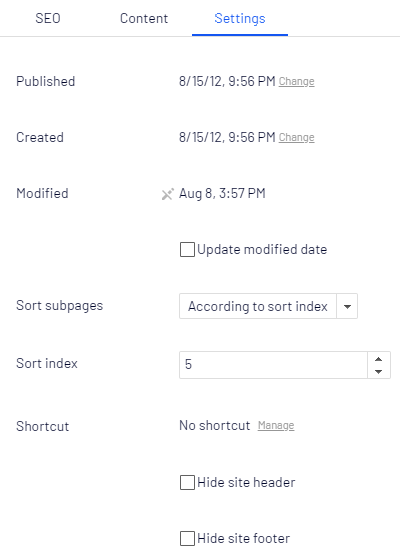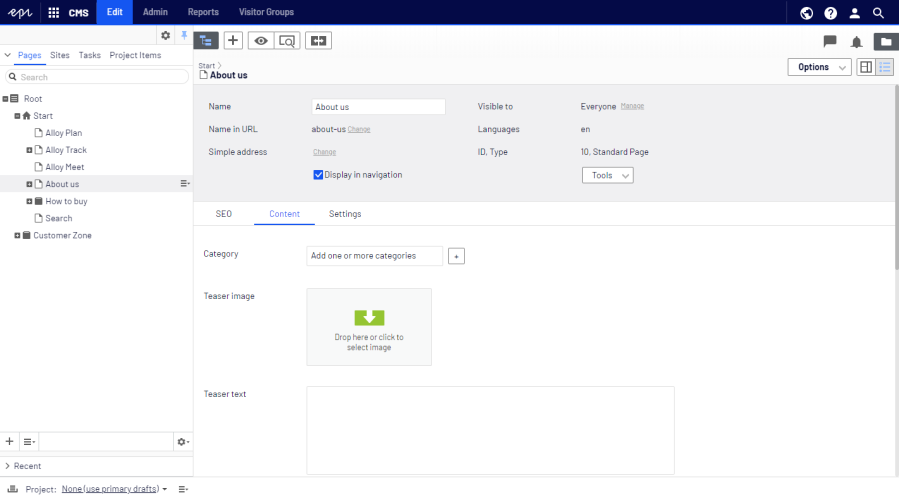 Working in All properties editing view
Working in All properties editing view
The All properties editing view provides editing access to all properties available for content, including those that are not available in the On-page editing view. Select All Properties in the toolbar to access these additional properties.

Areas and properties available for editing are implementation-specific, and depend on the type of content on your website. This topic describes some tabs and properties as they appear in the Optimizely sample templates.
Global properties
If you have content in multiple languages on your website, some properties may be locked for editing in a specific language. These properties are globally shared and you can edit them only in the master language The language in which the first version of content is created.. See Translating content.
Basic info properties
The top gray area displays the basic informational properties which are also accessible in the on-page editing view. This area appears in the All Properties editing view.
| Property | Description |
|---|---|
| Name | The name of the page. Depending on the implementation, this may be the heading of the page, and it is also shown in the page tree structure and menus. |
| Name in URL |
The page URL Stands for "Uniform Resource Locator". Also known as a web address such as http://world.optimizely.com. is automatically created based on the name of the page and its place in the navigation. It depends on the implementation if this is visible in links on the website. If you copy a page, the URL of the original page is copied with a number added to it. Change this if you create new content based on existing page copies.
Changing the URL for an existing page may cause broken links. |
| Simple address | This is a unique URL that can be added to frequently requested pages on your website, letting visitors locate the page simply by typing the simple address name directly after the main URL of the website. Providing, for example, products as a simple address lets you find the page just by entering the URL (for example, https://www.company.com/products) in the address bar of the browser even if the Products page is located further down in the navigation tree. You can use the Simple address report to manage simple addresses for your website. |
| Display in navigation | Deselect this option for pages that you do not want to be visible in navigation structures or menus on the website. |
| Visible to | Indicates if public access to the content is restricted. Click Manage to change these settings as described in Setting access rights from edit view. |
| Languages | Shows available languages for the content. If you have multiple languages on your website, see Working with multiple languages. |
| ID, Type | Shows the unique ID set by the system and the type of content on which the content is based. |
| Tools |
Under tools, you find the following options:
|
Tabs
All other properties are organized using tabs. These can be added and modified in code and from the administrative interface.
Content tab
The Content tab contains properties for entering the main content, when editing a page or a block in CMS, or catalog content if you have Optimizely Commerce installed.
| Property | Description |
|---|---|
| Category |
Categorization of content is useful in filtering functionality for search, navigation and listings. You create a category in the administrative interface before you can apply it to content in edit view. A category is a built-in property in Optimizely CMS. You can apply a category to content, but your website also needs customized functionality to display the resulting outcome, such as in a filtering. Also, do not confuse content categories with Optimizely Commerce categories; see Working with catalog entries. |
| Main body | Example of a rich-text editor property, for adding editorial content such as text, images and links. See Using the rich-text editor. |
Settings tab
The Settings tab is default and contains a set of built-in properties for managing publication dates, sort order and shortcuts.

| Property | Description |
|---|---|
| Published, Created and Modified | System-generated timestamps for the content that rarely need to be changed. |
| Update modified date | Select this check box if you have made significant changes to the content and want the system to update the modification date and include the content once more, such as in a subscription send-out. |
| Sort subpages and sort index | Defines the sort order for pages in the page tree structure and navigation menus. See Structuring the website. |
| Shortcut |
Creates menu or navigation links. A shortcut will not display any content of its own, instead it becomes a menu option linking directly to some other content on the same website or on an external website. Click Manage to add a shortcut for the page.
|
From the administrative interface, you can customize and configure default values for selected properties, or to make certain properties mandatory for editors to fill in. See Properties.
 Optimizely Commerce-related content
Optimizely Commerce-related content
On an e-commerce website, content can be catalog entries such as products and variants if you have Optimizely Commerce installed. Editing this type of content is similar to the editing of pages and blocks in CMS. See Managing content in the Commerce

